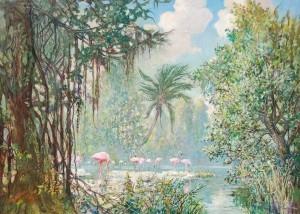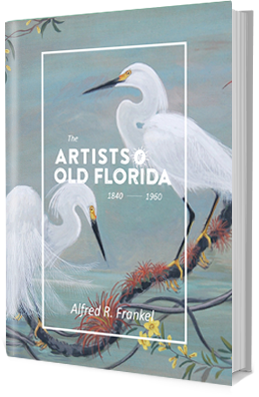 Jean Paleologue, Miami, Fla., 1942. Oil on canvas 27 by 37 inches.
Jean Paleologue, Miami, Fla., 1942. Oil on canvas 27 by 37 inches.
In the summer of 1927 Jean Paleologue opened a studio in St. Petersburg. The St. Petersburg Times, August 3, 1927 noted his arrival. Paleologue, “an artist of international fame, formed a class of students to study out of doors painting. On rainy days classes were held in his studio at 222 6th Avenue North.” Paleologue was Prince Paleologue, a direct descendant of the last Christian Emperor of Byzantine. His ancestor, Emperor Constantine XII, died on the ramparts of Byzantine, fighting the invading Turks in 1453. Paleologue was born in Romania and worked in England as a magazine illustrator and poster designer.
In 1893 he moved to Paris where he became seriously involved with poster design. In Paris Paleologue worked under the acronym, “Pal.” From 1893 to 1900 he designed hundreds of posters celebrating beautiful women. He is famous for his posters depicting the sensuous ladies of the Moulon Rouge and the Folies Bergere.
The St. Petersburg Times, February 19, 1928, “Paintings To Tell of State-Paleologue Finishes Second of Series of 21 Pictures to Advertise Florida. The immigration bureau, department of agriculture of Florida, is providing one of the finest series of oil paintings to depict the wealth and pleasures of the state that has ever been devised, and Jean Paleologue, St. Petersburg artist, is supplying the pictures. Mr. Paleologue was commissioned to paint 21 large oil paintings, 48 by 32 inches in size, and he has completed the first two. The second was exhibited Saturday at the Chamber of Commerce. It is a glimpse of a fine orange grove in the cutting season. The daughter of the grove owner is helping in the work and a little lad, her brother, is going after the sweet juice of a particularly lush Valencia. The Florida mule, the cutters on the ladders and the field boxes, together with the heavily laden trees, form part of the background. The first of the paintings, sent on to Tallahassee, was forwarded to Atlantic City for display in a show window there. The entire series will probably have wide use in colored posters, in newspaper advertising and other forms of spreading the gospel of sunny Florida. Mr. Paleologue has put his best command of drawing and color into these pictures. The atmosphere in the one displayed Saturday at the Chamber of Commerce has an especially fine treatment of winter light in the grove, and the foreground is a fine bit of detail.”
Paleologue moved to Miami in 1940 and died there in 1942. Just before his passing, the September 6, 1942 Miami Herald noted his work, “Today in his little studio at 14 S. W. 6th street., Paleologue gives hours to instruction of young students, does portraits on commission, and works on a hundred and one projects…. He showed us some lovely landscapes of Miami scenes that he did in a technique he has developed during the last year using transparent oils on dry enamel and ‘wiping out’ for white effects. He is also newly interested in a different kind of monotype, which he does in oil colors on a zinc plate. A number of these are on exhibition at the Washington Art Studio, in Miami Beach.
Born: 1855, Romania.
Died: 1942, Miami.
Education: In Europe.



